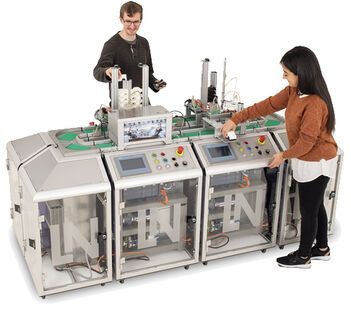IMU Industrial Mechatronic Unit - industry for the laboratory
- IMU 1 Industrial Mechatronic Unit
- IMU with IMS 3 subsystem Separation
- IMU with IMS 3 subsystem Separation with double magazine
- IMU with IMS 4 subsystem Upper part assembly
- IMU with IMS 4 subsystem Upper part assembly with double magazine
- IMU with IMS 5 Processing subsystem
- IMU with IMS 5 Processing subsystem with double magazine
- IMU with IMS 6 Testing subsystem
- IMU with IMS 7 Handling subsystem
- IMU with IMS 13 drilling and milling subsystem
- IMU with IMS 16 painting subsystem
- IMS 17 Labeling
- IMU with IMS 18 subsystem camera inspection
- IMU with IMS 19 subsystem quality control with AI

IMU Industrial Mechatronic Unit - industry for the laboratory
The Industrial Mechatronic Unit can be used to simulate industrial automated production systems of varying complexity. It is a system that is perfectly suited for further expansion due to its modular design. This means that the system can be adapted to the learner's previous knowledge and grow with it.
The Industrial Unit is characterized by the intelligent connection of the transport system with a control system in the control cabinet. Through the additional touch panel and the operating elements, any controls and sequences can be programmed.
- Through the use of industrial components, the trainee finds his way more quickly in the job after his training
- Multi-level training on only one system is possible.
- Basic understanding
- Advanced learners learn directly on the PLC of the transport system
- In advanced training, the networking of several transport systems with processing stations is carried out
- Small projects are carried out with IMS individual components, especially with the Mechatronic Unit or the individual stations
- Learners grasp the functional sequences and the signal state dependencies more quickly due to the possibility of being able to read the I/O signal states directly on the system
- More complex tasks can be handled with the IMS stations. Here, additional functional interrelationships result from the combination of individual IMS components
- Due to the easy separability of the systems, individual teaching designs are no problem
- Complete flexible production plants with circulation system are built up from connected IMS stations. The resulting multi-layered projects require the profound knowledge of the IMS stations.